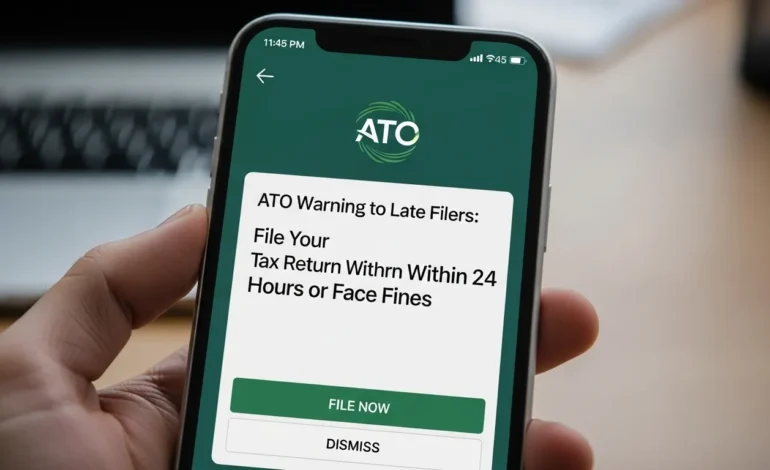ATO Warning to Late Filers: File Your Tax Return Within 24 Hours or Face Fines

Table of Contents
The Australian Taxation Office (ATO) warning has reached a critical moment for Australian taxpayers. As the deadline of 31 October 2025 approaches, the agency is urging individuals who have yet to lodge their 2024-25 tax returns to act immediately. The ATO has confirmed that failure to lodge on time triggers a “Failure to Lodge (FTL)” penalty of A$330 for each 28-day period (or part thereof) overdue, up to a maximum of A$1,650.
This strict approach underscores the ATO’s enforcement mindset for late filers. For taxpayers, this warning means there’s no cushion for delay—even one day can start the penalty clock ticking.
What the Deadline Means and Why It Matters
The ATO warning reminds every Australian that 31 October 2025 is the standard lodgement date for self-prepared individual tax returns. If you’re using a registered tax agent and you’ve appointed them before that date, you may get an extended lodgement window. The crucial point: failing to lodge on time—even if you plan to pay later—can lead to penalties. The penalty starts at A$330, increases in increments of 28 days, and caps at A$1,650 for individuals. For investors and taxpayers alike, this means any delay is costly. Looking ahead, ensuring lodging before or on 31 October is a strong financial safeguard.
How the Penalties Are Structured
Based on the ATO’s published framework, here is how the FTL penalty works:
- If you fail to lodge by 31 October and you are not using a tax agent, you may incur A$330 for the first 28-day period overdue.
- Each additional 28-day period, or part of it, adds another A$330 up to a maximum of A$1,650.
- For medium-sized entities (assessable income or GST turnover > A$1 m and < A$20 m), the multiplier is two. The penalty may therefore be higher.
This shows that the ATO is treating late lodgement not as a minor oversight but as a quantifiable financial risk. For taxpayers with side businesses or investment income, the cost of delay can escalate quickly.
Investor & Side-Hustle Taxpayers – Why You’re on the Radar
The ATO warning is particularly relevant for taxpayers earning income from side hustles, rental properties, or platform-based work. New data-matching technologies allow the ATO to track smaller income streams effectively. If you have multiple income sources (e.g., investing, freelancing, renting), the ATO expects you to declare them accurately and file on time. The presence of unreported income increases the risk of review and interest charges. According to the ATO, even if you believe your return will produce a refund, late lodgement triggers the same FTL penalty. For investors, this means diligent record-keeping and timely submission are essential to avoid damaging surprises.
Practical Tips for Tax-Savvy Investors
- Gather all relevant income statements early: employer payments, dividends, rental income, platform income. The ATO pre-fill data assists but may not capture everything.
- Check your deduction claims: the ATO reminds taxpayers the expense must have been spent by you, directly related to earning your income, and you must have a receipt.
- If you expect a tax liability, lodge early — remember the payment due date (for self-prepared returns) is 21 November 2025.
- If you cannot lodge on time, ensure you’re on the books of a registered tax agent before 31 October. That may afford you an extension.
- Beware of scams: tax-time scammers often use urgency to trick individuals. The ATO will not send links asking for bank details.
These steps help reduce risk and meet obligations with confidence.
Market Sentiment & Behavioural Impact on Tax Compliance
The ATO warning is sparking behavioural shifts. According to recent reporting, more than 8.7 million Australians had lodged by mid-October, but over two million were still outstanding. The sense of urgency has increased among taxpayers. Social-media sentiment reflects anxiety around missing the deadline. For example, a post on X (formerly Twitter) from a tax-advisor account reads:
“If you haven’t clicked submit by 31 Oct, you’re already facing the ATO’s $330 penalty & ripple-effects. Don’t risk it.”
This real-time update underscores the pressure. From an investor perspective, tax-compliance anxiety may reduce risk-taking behaviour in late October, as individuals focus on administrative tasks rather than portfolio moves. The ATO’s firm stance sends a signal: compliance timing matters as much as tax strategy.
Bottome Line
In summary, the ATO warning should not be ignored. The deadline of 31 October 2025 looms large, and the FTL penalty begins at A$330 and escalates if you delay. For anyone with investment income, side-hustle earnings or complex tax affairs, filing on time and accurately is the smart path. Engaging a tax agent ahead of time, validating your deductions, and submitting early will avoid unnecessary fees and interest. For investors, staying compliant frees you to focus on returns, not penalties. Meet your lodgement obligation, check your records, and submit without delay.
FAQs
What happens if I miss the 31 October deadline and I owe tax?
If you miss the deadline and you owe tax, you still incur the FTL penalty starting at A$330. The tax-bill payment deadline remains 21 November 2025 for self-prepared returns. You also risk General Interest Charge (GIC) on any unpaid tax.
Can I avoid the penalty by using a tax agent?
Yes — but only if you appoint the agent before 31 October 2025. Then you may qualify for the later lodgement date allocated to the agent. If you don’t, you’re still liable for the penalty.
Does the penalty apply if I’m due a refund?
Potentially yes. The ATO’s FTL penalty framework applies even when a return results in a refund unless special conditions exempt you. You still must lodge on time to avoid triggering the fine simply for missing the deadline.
How much can the penalty escalate for businesses?
For a medium-sized entity with assessable income between A$1 m and A$20 m, the penalty units are multiplied by two. For large entities (A$20 m+ turnover), the multiplier is five. That means the cost of late lodgement rises significantly for larger taxpayers.




